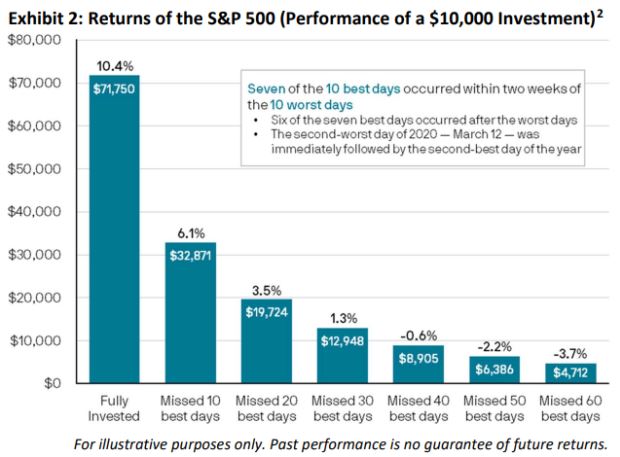(Download the full report HERE) The phrase “Don’t just do something, stand there.”—made famous by the White Rabbit in “Alice in Wonderland”—is both a whimsical and profound reminder of the importance of restraint. In a world that often urges quick action, particularly in high-stakes or high-pressure situations, the message challenges the human tendency to react immediately to new information. In fact, there are many instances where pausing might be the most strategic approach. In the realm of investing, individuals or investment committees may feel compelled to react to a constant stream of news, including rapid-fire headlines about inflation, tariffs, a possible recession, and geopolitical and technological changes. The temptation to act quickly can be strong. But sometimes, standing still and resisting the urge to act can yield far better results in the long run. Market volatility can trigger strong emotional reactions, leading investors to question their strategies. When markets decline sharply, the instinct to sell or de-risk a portfolio can be overwhelming. However, making investment decisions based on short-term market moves often leads to costly mistakes. Exhibit 2 illustrates the long-term impact of missing the best trading days in the stock market by analyzing the performance of a theoretical $10,000 investment in the S&P 500 from 2005 through 2024. In this example, a fully invested hypothetical portfolio of $10,000 would have grown to $71,750, achieving an annualized return of 10.4%. However, missing just the 10 best days reduced the final value to $32,871, and missing the 60 best days resulted in a significant decline to $4,712, an annualized return of -3.7%! A fundamental feature of markets is that the worst periods often create conditions for the strongest recoveries. During the COVID-19 crash in March of 2020, the second-worst day of the year, March 12th, was followed by the second-best day of the year. Attempting to time the market based on short-term news cycles frequently leads to costly mistakes, as investors tend to exit during downturns and reenter after recoveries have begun, locking in losses while missing potential gains. In addition to broad market indices, company-specific news can cause unforeseen swings in individual stocks. Exhibit 3 tracks U.S. Steel’s volatile price movements from August 2024 to February 2025, showing how announcements regarding the Nippon Steel acquisition and shifting political stances drove significant fluctuations. For instance, the stock plummeted when President Biden opposed the deal but later soared following Donald Trump’s election victory and tariff pledges. These abrupt reversals highlight the difficulty of predicting market movements based on short-term events. Investors who sold during downturns—such as when Biden was expected to block the deal—would have locked in losses, missing subsequent rebounds when market sentiment shifted. To read the Full Report, click HERE. Sources: Interested in learning more? The professional advisors at ACG are happy to answer any questions youACG Insights: Patience Over Panic
Executive Summary:
Introduction
The Perils of Reacting to Every Headline


Connect With Us
have. Contact us to discuss solutions and discover how our advisors bring value to your institution.

